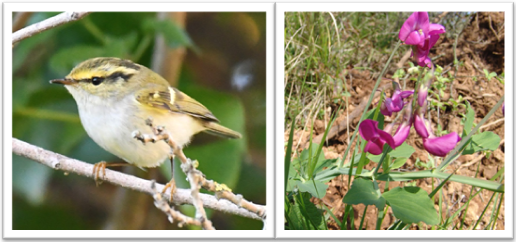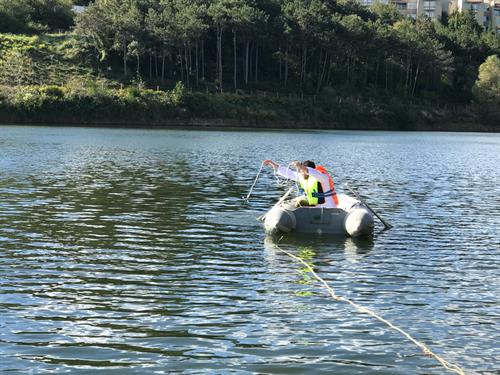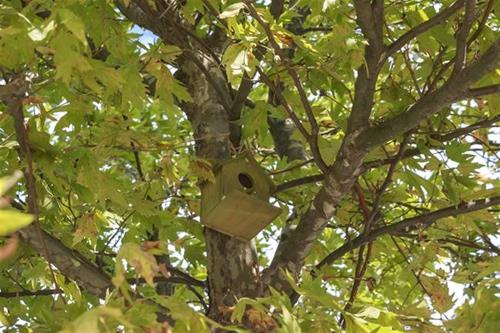ITU Campus Biodiversity
ITU Ayazağa Campus hosts various ecosystems and rich biodiversity. The campus located at the center of the city plays an important role for numerous species. There are more than 160 bird species recorded in the campus.Notably, the campus is a habitat for endemic plant species like Lathyrus undulatus (known as the İstanbul Nazendesi) and rare bird species such as Phylloscopus proregulus (Pallas's leaf warbler), which was recorded for the second time in Istanbul and only the seventh time in all of Turkey.
ITU actively promotes the significance of campus biodiversity through bioblitz events and news highlighting the campus's important species.

The news page for Pallas's leaf warbler: https://sustainability.itu.edu.tr/en/news-detail/2022/11/22/pallas's-leaf-warbler-in-itu
ITU Biodiversity pages:
https://www.inaturalist.org/projects/itu-ayazaga-kampusu-biyocesitliligi
https://ebird.org/hotspot/L7866261
Animal species on campus
There are different bird species such as parrots, hawks and magpies on campus. Reptiles, squirrels, hedgehogs, cats and dogs are other types of animals that live on campus. In the areas where dogs gather on campus, cabins have been created where they can meet their eating and drinking needs. All dogs and cats have been vaccinated and a veterinarian has been appointed to control their health.
ITU Pond
The ITU Pond serves as an aquatic ecosystem surrounded by a rich flora and woodlands. The pond host various fish and birds including ducks, herons, grebes, and cormorants.
In 2016, the interior and surroundings of the pond were rehabilitated. With the new spillway operation, if the water rises in the pond, the water can overflow and flow down the open channel in a controlled manner and go to the collector without damaging the body. Especially taking into account the periods when the rain is low or the times when there is a drought problem, the artificial pond fed with rain water has been made ready for all conditions. By taking advantage of the topography, minimum energy consumption has been achieved in transferring water to irrigation systems.
In order to protect and sustain the biological diversity in Ayazağa Campus, studies were carried out with the support of the botany department and with the contributions of Istanbul University. Birds, plant community, fish, butterflies and insects were observed in the pond area. Some scientific studies are also carried out in the pond without disturbing the natural life, and the rowing team and the pedalo club can also train in the pond.
Protection of Species and Biodiversity
ITU conducts different works to maintain and extend existing ecosystems. In order to maintain the biodiversity on the campus, many experts and academicians in different fields are collaborating. Ecosystem sustainability, water-efficient irrigation, innovative landscape design and measures to maintain campus animals are the main concerns. ITU has also a veterinary unit to take care of campus animals. The main objective of the unit is to provide well living conditions for campus animals, especially stray dogs. ITU considers the land ecosystem during new constructions and transplants trees as well as valuable vegetable soil if it is feasible technically.
Monitoring and Evaluation of the ITU Pond
ITU monitor and evaluate the chemical and biological changes of the pond’s water

Please see the following link for more details:
https://sustainability.itu.edu.tr/sustainable-itu/water-management-in-itu/water-measure-in-the-itu
Bottom cleaning and thinning works in the forest
Since the leaves that fall in the forests of ITU Maslak Campus are needled, they do not allow the development of grass value on the ground. These needle leaves on the forest floor are collected with the bottom cleaning
Bird's Nests
It has been observed that the sparrows are moving away from the forests with the increasing number of animal species such as crow and magpie in the Ayazağa Campus. Bird nests were placed throughout the campus so that the sparrows could return to the forest and, with the bird nests, the sparrow population increased.

Fighting Against Alien Species:
ITU takes action against invasive alien species to protect campus biodiversity.
Invasive alien species are organisms that are non-native to an ecosystem, and which may cause environmental harm or adversely affect ecosystem health.
Actions plans against invasive alien species is also embodied by ITU Directive on the Conservation and Sustainable Use of Biodiversity and Ecosystems.
Please see the following links for more details:
https://impact.itu.edu.tr/fighting-against-alien-species
https://sustainability.itu.edu.tr/sustainability-office/policies/itu-directive-on-the-conservation-and-sustainable-use-of-biodiversity-and-ecosystems